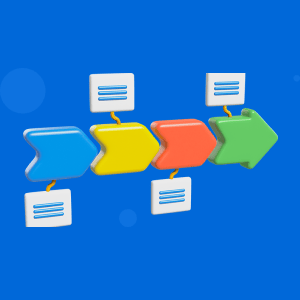xAPI
Table of Contents
Learners can acquire knowledge, skills, and abilities in several unique ways. The typical learning experience involves enrolling in a workshop or course, completing it, and then moving on to the next one. In this traditional learning process, the only place where data is collected about the learner is when they are marked as having attended or successfully completed the training.
However, this does not provide in-depth measurements of insights into the learner’s experience nor assess if they understand the content. Additionally, such inadequate forms of data collection do not account for additional learning experiences that may be relevant, such as hands-on practice, reading books, troubleshooting errors, talking with mentors, or external education resources.
Historically, this limited method of data collection forced talent development teams to rely on guesswork instead of real insights from the training. Luckily, a new technology specification now allows developers to track 100% of learning experiences.
Picture learning experiences as different puzzle pieces scattered randomly across a table. Creating the right content for training requires you to identify each puzzle piece and consolidate them to form relevant learning content. So, what is xAPI and how does it fit into the overall puzzle you are trying to assemble?
Let’s see how! This article will cover:
- What is xAPI?
- How does xAPI fits into your learning programs
- How xAPI works
- Advantages of using xAPI
What is xAPI?
API stands for application programming interface, which is a term for the connection between different technical systems that can share data with each other. The ‘x’ in xAPI stands for experience, implying that activity providers are not limited to conventional Sharable Content Object Reference Model (SCORM) and Aviation Industry Computer-Based Training Committee (AICC) e-learning. xAPI refers to how learning activities should be reported between the different technical systems.
In other words, xAPI is a straightforward, clear solution for storing and accessing learners’ records and sharing them across other platforms. It captures records referred to as activity statements with a consistent format from several unrelated sources called activity providers and aggregates them in a learning record store (LRS). The LRS operates as the SCORM database in a learning management system (LMS).
API and xAPI allow you to monitor learners participating in online communities, workshop activities, performance assessments, and mentoring discussions. It aims to paint the complete picture of an individual’s learning experience. From there, users can relate the data to learners’ immediate and future performance.
What is xAPI’s role in your learning ecosystem?
Essentially, xAPI refers to how various parts of the learning ecosystem can interact and share data from learner experiences at each stage of training. It is an application programming interface, a way for various software products to talk to each other even when made for different teams or unique functionality.
The Advanced Distributed Learning (ADL) Initiative created and continues to maintain xAPI to simplify how e-learning content is stored and distributed across platforms. Additionally, it allows for seamless performance tracking by drawing learning data from the real and digital worlds.
Learning and development teams can use xAPI without sophisticated developer skills. In fact, anyone who has used e-learning solutions probably used a system with xAPI or some of its predecessors.
A brief history of experience API and Tin Can
Before and around 2010, e-learning reporting technology relied heavily on manual processes. It lagged behind the tech progress in adjacent areas. However, as the world transitioned toward mobile devices and the cloud, e-learning had to adapt to changing demands.
The development of xAPI began in 2011 as Project Tin Can. Its goal was to eliminate the inadequacies of e-learning platforms. The ADL Initiative wanted to revamp SCORM to align with modern e-learning needs. Later in 2013, a community working group developed and launched xAPI, also commonly referred to as the ADL Tin Can API.
Currently, many systems and content vendors in the e-learning space adopt xAPI. The solution is highly flexible and scalable. Because it’s also backward compatible with SCORM, users view it as the new de-facto standard.
How xAPI works
An API provides interoperability within different systems, websites, applications, and more. In xAPI, the activity provider generates xAPI statements, and the LRS endpoint receives them and stores them in a database.
The activity provider can be the LMS, simulations, standalone courses, or medical devices. xAPI allows for several recording and tracking options to occur offline, but the statements will transmit simultaneously after a user completes an action or after restoring the internet connection. The activity provider can still get involved in other activities in the real world without connecting to the xAPI tracking systems and use the Tin Can API to update the statement later.
Those with silos of data in the corporate database can share random data objects in the LRS with xAPI. This access to analysis helps users get the most recent results for progress tracking.
LRS is the center of learning activities
xAPI data collected from learners’ activity consists of behaviors and performance data. These detail the various actions learners complete during the learning process and assessments. In some cases, their choices are more critical than the overall result. xAPI has reliable tracking features to capture individual user choices in the learning journey with complete precision.
xAPI stores the experiences and insights from learning activities in the LRS, a cloud repository. The activity provider must have an LRS address with xAPI specification before publishing to know where it reports.
This is different from a typical learning management system that performs functions like:
- Storing learning paths
- Managing users and content
- Offering courses to learners
- Providing charts, calendars, and other organizational tools
With an LRS, users can receive and store statements on single lists and reports to provide learning analytics. Ultimately, an LRS aims to free learners from traditional learning platforms so you can place e-learning content wherever you want.
What xAPI tracks
So, what is xAPI offering that’s so different from earlier iterations? Unlike xAPI predecessors, the modern version tracks every activity learners do within the learning environment. These include simple to complex actions like watching videos, interacting with a simulation, reading an e-book, and other real-world performances. This is much more in-depth than simply providing points and progress percentages.
Some of the learner activities trainers might track in various fields of study include:
- Which parts of a video that learners skip in an economics course
- The tools learners used first in virtual reality (VR) simulation for a neurosurgery procedure
- The physical buttons learners press on a plane simulator during takeoff
- Geolocation and heat rate data of runners preparing for a marathon
- Hundreds of other activities, parameters, and details that are required to create the complete picture of learner performance
Tin Can API operates without any predetermined command sets. So it’s up to the learning and development teams and authoring tool developers to configure the xAPI with the activities it should report and when. However, e-learning authoring tools that can publish xAPI courses have wrappers configured to publish statements.
Devices xAPI supports
The major reason for developing xAPI was to create a solution to support tablets and mobile device use. xAPI supports all possible devices with internet access. It also offers the highest level of interoperability for reporting systems and learning activities.
Reasons to implement xAPI in your learning content
xAPI’s ability to meticulously track learning experiences and personalize learning content is ideally suited for scenarios where long-term, adaptive, blended, and interactive learning are major requirements.
Here are some of the top benefits that xAPI offers organizations that are serious about achieving ambitious learning and development goals:
1. Informal learning
Research has found that about 75% of an employee’s learning comes from informal venues. And yet, many organizations spend the bulk of their time, money, and focus on formal learning and training.
While employees may complete formal or mandatory training, many will also learn through informal methods like a learning object repository, YouTube videos, social media, or books. With xAPI, you can track informal and social learning that accompanies formal or mandatory training.
2. True mobile learning
What’s referred to as “true mobile learning” is more than responsive websites or screens that scale down automatically when viewed on smaller devices. xAPI does not need a dedicated browser when running and managing online courses. Users can design and deploy courses for smartphone users via mobile apps.
Learning apps continue to be robust and interactive with more accessibility. xAPI plays a significant role in increasing workplace transitions from conventional LMS to LXP (learning experience platform) with dedicated mobile learning apps.
3. Offline learning
But, what is xAPI doing to provide offline learning so there’s no interruption to the learning experience? This is arguably the biggest advantage of implementing xAPI. Learners can complete courses and learning activities offline, record the activity statement later, and store it on the LRS when there is an internet connection. This is a big deal, especially in countries where there are issues with full-scale data connectivity.
4. Enhanced tracking
Online learning can take many forms, and you need to track every activity to fully understand the learner’s performance and behavior. As learning systems change, you need a solution like xAPI to track learner progress across several scenarios and channels.
Real-time tracking is ideal for blended learning, engaging simulations, puzzling assessments, or games in your e-learning program. Whenever a learner completes a specific task, the data automatically feeds into the LRS. This offers accurate insights for analyzing performance and progress.
The future of online learning is all about data and offering personalized learning paths. Course administrators can future-proof their learning courses for individual learners with xAPI capabilities. In addition, it provides complete control for monitoring learners at every stage of learning.
So, how will you implement xAPI?
Modern companies and consultants have already made moves to implement xAPI in their organizations and for their clients. It is a viable option when you want something that can track activities that SCORM can’t handle. Luckily, getting started with xAPI is effortless and straightforward.
Docebo offers a reliable LMS to help users utilize xAPI-compliant learning and training material. Our platform will tackle all learning challenges you may face for a smooth implementation process and learning experience. Please visit our glossary today for relevant resources to learn more.








